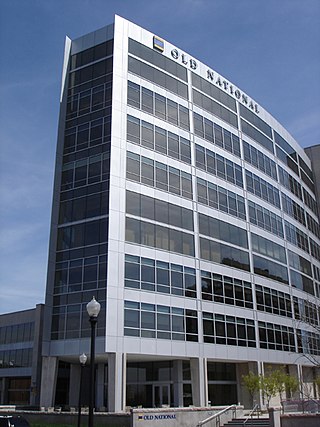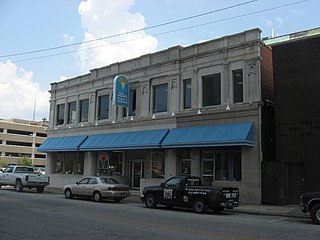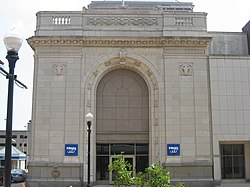
The Federal Deposit Insurance Corporation (FDIC) is a United States government corporation supplying deposit insurance to depositors in American commercial banks and savings banks. The FDIC was created by the Banking Act of 1933, enacted during the Great Depression to restore trust in the American banking system. More than one-third of banks failed in the years before the FDIC's creation, and bank runs were common. The insurance limit was initially US$2,500 per ownership category, and this has been increased several times over the years. Since the enactment of the Dodd–Frank Wall Street Reform and Consumer Protection Act in 2010, the FDIC insures deposits in member banks up to $250,000 per ownership category. FDIC insurance is backed by the full faith and credit of the government of the United States, and according to the FDIC, "since its start in 1933 no depositor has ever lost a penny of FDIC-insured funds".

In the United States, banking had begun by the 1780s, along with the country's founding. It has developed into a highly influential and complex system of banking and financial services. Anchored by New York City and Wall Street, it is centered on various financial services, such as private banking, asset management, and deposit security.
A savings and loan association (S&L), or thrift institution, is a financial institution that specializes in accepting savings deposits and making mortgage and other loans. The terms "S&L" and "thrift" are mainly used in the United States; similar institutions in the United Kingdom, Ireland and some Commonwealth countries include building societies and trustee savings banks. They are often mutually held, meaning that the depositors and borrowers are members with voting rights, and have the ability to direct the financial and managerial goals of the organization like the members of a credit union or the policyholders of a mutual insurance company. While it is possible for an S&L to be a joint-stock company, and even publicly traded, in such instances it is no longer truly a mutual association, and depositors and borrowers no longer have membership rights and managerial control. By law, thrifts can have no more than 20 percent of their lending in commercial loans—their focus on mortgage and consumer loans makes them particularly vulnerable to housing downturns such as the deep one the U.S. experienced in 2007.

The savings and loan crisis of the 1980s and 1990s was the failure of 32% of savings and loan associations (S&Ls) in the United States from 1986 to 1995. An S&L or "thrift" is a financial institution that accepts savings deposits and makes mortgage, car and other personal loans to individual members.

The Community Reinvestment Act is a United States federal law designed to encourage commercial banks and savings associations to help meet the needs of borrowers in all segments of their communities, including low- and moderate-income neighborhoods. Congress passed the Act in 1977 to reduce discriminatory credit practices against low-income neighborhoods, a practice known as redlining.

National City Corporation was a regional bank holding company based in Cleveland, Ohio, founded in 1845; it was once one of the ten largest banks in America in terms of deposits, mortgages and home equity lines of credit. Subsidiary National City Mortgage is credited for doing the first mortgage in America. The company operated through an extensive banking network primarily in Ohio, Illinois, Indiana, Kentucky, Michigan, Missouri, Pennsylvania, Florida, and Wisconsin, and also served customers in selected markets nationally. Its core businesses included commercial and retail banking, mortgage financing and servicing, consumer finance, and asset management. The bank reached out to customers primarily through mass advertising and offered comprehensive banking services online. In its last years, the company was commonly known in the media by the abbreviated NatCity, with its investment banking arm even bearing the official name NatCity Investments.

Old National Bank is an American regional bank with nearly 200 retail branches operated by Old National Bancorp and based in Chicago, Illinois, and Evansville, Indiana. With assets at $23.0 billion and 162 banking centers, Old National Bancorp is the largest financial services bank holding company headquartered in Indiana and one of the top 100 banking companies in the U.S. Its primary banking footprint is in Illinois, Indiana, Kentucky, Michigan, Minnesota, and Wisconsin.
NetBank, formerly named Atlanta Internet Bank (1996) and Net.B@nk (1998), was a direct bank.

The R & G Financial Corporation was a financial holding company located in San Juan, Puerto Rico. On April 30, 2010, its bank failed and its deposits and assets were seized by the Federal Deposit Insurance Corporation (FDIC). Its deposits and assets were subsequently sold to Scotiabank. On May 14, R & G Financial Corporation filed for Chapter 11 bankruptcy.
All regulated financial institutions in the United States are required to file periodic financial and other information with their respective regulators and other parties. For banks in the U.S., one of the key reports required to be filed is the quarterly Consolidated Report of Condition and Income, generally referred to as the call report or RC report. Specifically, every National Bank, State Member Bank and insured Nonmember Bank is required by the Federal Financial Institutions Examination Council (FFIEC) to file a call report as of the close of business on the last day of each calendar quarter, i.e. the report date. The specific reporting requirements depend upon the size of the bank and whether or not it has any foreign offices. Call reports are due no later than 30 days after the end of each calendar quarter. Revisions may be made without prejudice up to 30 days after the initial filing period. Form FFIEC 031 is used for banks with both domestic (U.S.) and foreign (non-U.S.) offices; Forms FFIEC 041 and 051 is for banks with domestic (U.S.) offices only.

The Victory Theatre is a 1,950 seat venue in Evansville, Indiana. It is home to the Evansville Philharmonic Orchestra and also hosts local ballet and modern dance companies, theatre companies, and touring productions.
IndyMac, a contraction of Independent National Mortgage Corporation, was an American bank based in California that failed in 2008 and was seized by the United States Federal Deposit Insurance Corporation (FDIC).

WSFS Financial Corporation is a financial services company. Its primary subsidiary, WSFS Bank, a federal savings bank, is the largest and longest-standing locally managed bank and trust company headquartered in Delaware and the Greater Delaware Valley. WSFS operates from 114 offices, 88 of which are banking offices, located in Pennsylvania (59), Delaware (39), New Jersey (14), Virginia (1) and Nevada (1) and provides comprehensive financial services including commercial banking, retail banking, cash management and trust and wealth management.
Corus Bankshares, Inc. operated as the holding company for Corus Bank, N.A., a United States company that offered consumer and corporate banking products and services.
Nevada State Bank, a division of Zions Bancorporation, N.A. Member FDIC, is a full-service bank with branches statewide. Founded in 1959, Nevada State Bank serves 20 communities across the state of Nevada. Zions Bancorporation, N.A. operates in nearly 500 local financial centers across 11 Western states: Arizona, California, Colorado, Idaho, Nevada, New Mexico, Oregon, Texas, Utah, Washington and Wyoming. Zions Bancorporation, N.A. is included in the S&P 500 and NASDAQ Financial 100 indices.
The New York State Banking Department was created by the New York Legislature on April 15, 1851, with a chief officer to be known as the Superintendent. The New York State Banking Department was the oldest bank regulatory agency in the United States.
First Midwest Bancorp, Inc was headquartered in Chicago, Illinois, just east of O'Hare Airport. The company's predecessor traces back to Joliet, Illinois. From there the company has grown to serve many Chicago suburbs including northwest Indiana, downstate Illinois, southeast Wisconsin and the Quad Cities area including Iowa. First Midwest Bank is one of the largest banking institutions in the United States

Bank of Utah is a federally-insured community bank, with corporate headquarters in Ogden, Utah. It is a member of the Utah Bankers Association (UBA), the American Bankers Association (ABA), and the Federal Deposit Insurance Corporation (FDIC). Branden P Hansen is president of Bank of Utah, as of January 2023.

Signature Bank was an American full-service commercial bank headquartered in New York City and with 40 private client offices in the states of New York, Connecticut, California, Nevada, and North Carolina. In addition to banking products, specialty national businesses provided services specific to industries such as commercial real estate, private equity, mortgage servicing, and venture banking; subsidiaries of the bank provided equipment financing and investment services. At the end of 2022, the bank had total assets of US$110.4 billion and deposits of $82.6 billion; as of 2021, it had loans of $65.25 billion.

Evansville Journal News, also known as the Citizens Bank Building-Evansville Journal Building, is a historic commercial building located in downtown Evansville, Indiana. It was built in 1910, and is a two-story, Beaux-Arts style brick building with a limestone front. The building was originally built to house a newspaper.














